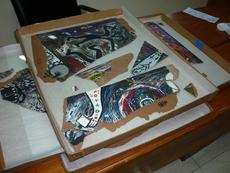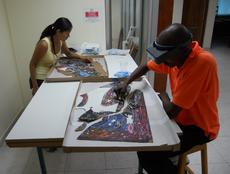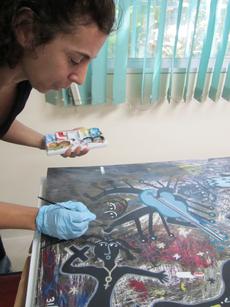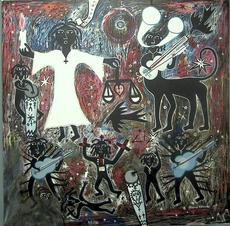 The eighteen-month long Smithsonian Institution Haiti Cultural Recovery Project was an international, collaborative, conservation effort to recover cultural patrimony gravely damaged by the January 12, 2010 earthquake. As Chief Conservator and Paintings Conservator, respectively, Stephanie directed conservation activities to support projects at twenty public and private institutions, and Viviana oversaw the paintings conservation activities. Here we relate the story of one remarkable conservation treatment and its context, the recovery of a fragmented Stivenson Magloire painting, mentioned in an earlier blog post here on The Bigger Picture.
The eighteen-month long Smithsonian Institution Haiti Cultural Recovery Project was an international, collaborative, conservation effort to recover cultural patrimony gravely damaged by the January 12, 2010 earthquake. As Chief Conservator and Paintings Conservator, respectively, Stephanie directed conservation activities to support projects at twenty public and private institutions, and Viviana oversaw the paintings conservation activities. Here we relate the story of one remarkable conservation treatment and its context, the recovery of a fragmented Stivenson Magloire painting, mentioned in an earlier blog post here on The Bigger Picture.
The painting, Untitled (1988) by Stivenson Magloire, an acrylic on Masonite panel, presented the most complicated  structural damage we faced during our work in Haiti. “Victims” or “corpses” were words our assistants used to describe paintings in this condition. A select group of works, like the Magloire painting, deemed by Haitian colleagues to be of high cultural value, received advanced conservation treatment, sometimes taking months to complete. Any well-equipped conservation lab in the world would have found these issues to be very complex. Our conservators had the added challenge of working in makeshift studios—retrofitted office suites—which we equipped from the ground-up by hand-carrying supplies and equipment in our luggage.
structural damage we faced during our work in Haiti. “Victims” or “corpses” were words our assistants used to describe paintings in this condition. A select group of works, like the Magloire painting, deemed by Haitian colleagues to be of high cultural value, received advanced conservation treatment, sometimes taking months to complete. Any well-equipped conservation lab in the world would have found these issues to be very complex. Our conservators had the added challenge of working in makeshift studios—retrofitted office suites—which we equipped from the ground-up by hand-carrying supplies and equipment in our luggage.
 Ten months after the earthquake, Maria Isabel Moreno, proprietor of Galerie Flamboyant in Port-au-Prince, read about our recovery project in a local newspaper. She met with Stephanie, to recount the story of the contents she carefully carried in a large folder, hoping we could undertake the extensive repair needed. On that tragic January day, Maria Isabel, who owns one of the largest collections of Magloire paintings, returned to her gallery at the Hotel Montana to retrieve her favorite Magloire when the earthquake struck and buried her. Surviving a serious concussion, she crawled up and out of the collapsed hotel, where two hundred people died. Later her son returned to retrieve the favorite painting, now in twenty-two separate fragments, from the rubble.
Ten months after the earthquake, Maria Isabel Moreno, proprietor of Galerie Flamboyant in Port-au-Prince, read about our recovery project in a local newspaper. She met with Stephanie, to recount the story of the contents she carefully carried in a large folder, hoping we could undertake the extensive repair needed. On that tragic January day, Maria Isabel, who owns one of the largest collections of Magloire paintings, returned to her gallery at the Hotel Montana to retrieve her favorite Magloire when the earthquake struck and buried her. Surviving a serious concussion, she crawled up and out of the collapsed hotel, where two hundred people died. Later her son returned to retrieve the favorite painting, now in twenty-two separate fragments, from the rubble.
This fragmented painting was one of the most devastating sights Viviana had  encountered during her twenty-five-year career as a paintings conservator. Two assistants were assigned to the treatment, Saori Kawasumi, graduate conservation student at Buffalo State College, and Erntz Jeudy, artist and conservation assistant.
encountered during her twenty-five-year career as a paintings conservator. Two assistants were assigned to the treatment, Saori Kawasumi, graduate conservation student at Buffalo State College, and Erntz Jeudy, artist and conservation assistant.
Viviana and Saori completed the condition report by testing the panel’s pH and the solvent solubility of the paint layer and primer. They then organized a sequential treatment list and discussed the most difficult aspects of its condition as well as the different treatment approaches. For most materials, re-attaching broken pieces is not a straightforward process, because the edges expand. In addition, internal breaks within the support had produced bulging areas on the painted surface with hardly any access to introduce even a slim scalpel blade, as well as significant planar distortions. Above all, stabilizing the thinly painted surface presented the most critical aspect of the treatment.
The meticulous treatment tasks required excruciating patience. As treatment progressed we found the right solution for each problem through testing, trial and error. We glued back together delaminated areas with neutral adhesive and Japanese paper backings as needed, flattened protruding cardboard and uneven edges, and filled gaps with blotter paper. Once the piece was reassembled (you can see a timelapse video of its reassembly here) it was mounted to another rigid support (a corrugated plastic panel) with a Tyvek interlayer to facilitate reversibility. To compensate the large corner loss the area was filled with a blotter paper laminate and a synthetic filler. The filled area was retouched to integrate the imagery and colors.
 A retrospective of Magloire’s paintings opened at Galerie Flamboyant on December 8, 2011 at the reconstructed Hotel Montana. The successfully treated painting was the centerpiece of the exhibition. Smithsonian project conservation staff joined other guests at the kind of art event that seemed impossible to imagine since the earthquake. It felt like a rare triumph, emblematic of our project’s conservation efforts, and evocative more generally of the damage wrought by the earthquake and Haiti’s painstaking progress toward recovery. In celebrating together, we soberly appreciated the importance of this positive outcome to a story with such dire beginnings.
A retrospective of Magloire’s paintings opened at Galerie Flamboyant on December 8, 2011 at the reconstructed Hotel Montana. The successfully treated painting was the centerpiece of the exhibition. Smithsonian project conservation staff joined other guests at the kind of art event that seemed impossible to imagine since the earthquake. It felt like a rare triumph, emblematic of our project’s conservation efforts, and evocative more generally of the damage wrought by the earthquake and Haiti’s painstaking progress toward recovery. In celebrating together, we soberly appreciated the importance of this positive outcome to a story with such dire beginnings.
For more information on the project, please see the book, Saving Haiti’s Heritage: Cultural Recovery after the Earthquake (Smithsonian Institution Press, 2011), by Richard Kurin, Under Secretary for History, Art and Culture at the Smithsonian. Fifty conservators and collection managers in contract, staff, and volunteer capacities contributed foreign expertise to our project, stabilizing over thirty thousand art works, documents, and monuments, and training over one hundred Haitian colleagues in preservation methods. You may contact the authors at: shornbeck@caryatid-conservation.com (Stephanie) and art.conservation.services@gmail.com (Viviana).
Produced by the Smithsonian Institution Archives. For copyright questions, please see the Terms of Use.

Leave a Comment